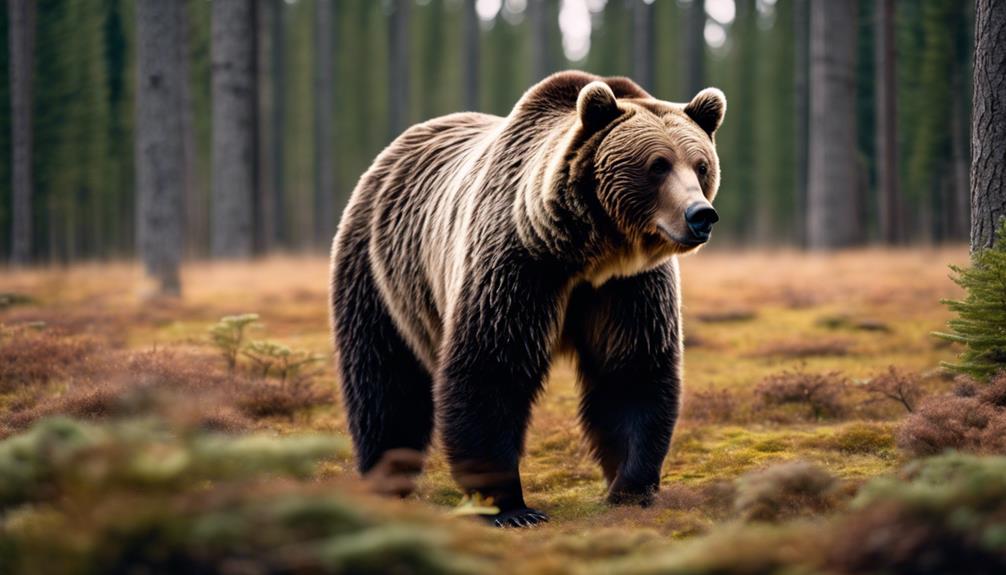Imagine standing face to face with a grizzly bear, its massive frame casting a shadow over you. You might wonder about the dimensions of these majestic creatures—how big do they really get?
The numbers might surprise you, shedding light on the impressive stature of these powerful animals. From their towering height to their formidable weight, grizzly bears possess dimensions that command respect and admiration.
But there’s more to discover beyond just their size; delve deeper into their anatomy to uncover fascinating details that paint a complete picture of these iconic beasts.
Grizzly Bear Size Overview
When observing grizzly bear dimensions, one can witness a notable variation in size between male and female individuals. Male grizzly bears can reach impressive shoulder heights of 36-46 inches and weigh between 400-800 lbs, while females have slightly smaller shoulder heights averaging 30-38 inches and weigh around 300-400 lbs. Both genders exhibit a body length ranging from 56-88 inches, with standing heights reaching 8-9 feet. In captivity, these majestic creatures can live up to 45 years, exceeding the lifespan of their wild counterparts, which typically ranges from 20-25 years.
The size differences in grizzly bears are influenced by various factors such as sex, age, health, and nutrition. These factors play a crucial role in determining the overall dimensions of these magnificent creatures. Understanding the size variations in grizzly bears provides valuable insights into their biology and behavior, highlighting the fascinating diversity that exists within this species.
Height of Grizzly Bears
Grizzly bears exhibit impressive shoulder heights ranging from 30 to 46 inches, varying between male and female individuals. Males typically have a shoulder height between 36 to 46 inches, while females range from 30 to 38 inches. When standing fully upright, these majestic bears can reach heights of 8 to 9 feet, showcasing their imposing presence in the wild.
The average body length of a grizzly bear spans from 56 to 88 inches, contributing to their overall size and strength. In terms of weight, male grizzly bears can weigh between 400 to 800 lbs, with the largest grizzly bears tipping the scales at impressive figures. On the other hand, female grizzly bears generally weigh between 300 to 400 lbs, demonstrating slighter proportions compared to their male counterparts.
The shoulder height of grizzly bears plays a significant role in their physical stature and dominance within their habitats.
Weight of Grizzly Bears
In determining the physical condition and overall well-being of a grizzly bear, their weight serves as a crucial metric reflecting various environmental and biological factors. Grizzly bears can weigh between 400 to 1500 pounds, with males typically reaching weights up to 1000 pounds. Female grizzlies, on the other hand, average between 300 to 400 pounds, influenced by factors such as age, health, and nutrition.
Seasonal variations in weight are common among grizzly bears, with lighter weights in spring as they emerge from hibernation and heavier weights in autumn as they prepare for winter. The weight of a grizzly bear isn’t only a result of their sex but is also impacted by their overall health and the availability of food resources in their habitat.
Monitoring the weight of grizzly bears is essential in understanding their health, reproductive fitness, and ability to thrive in their environment.
Grizzly Bear Paw Size
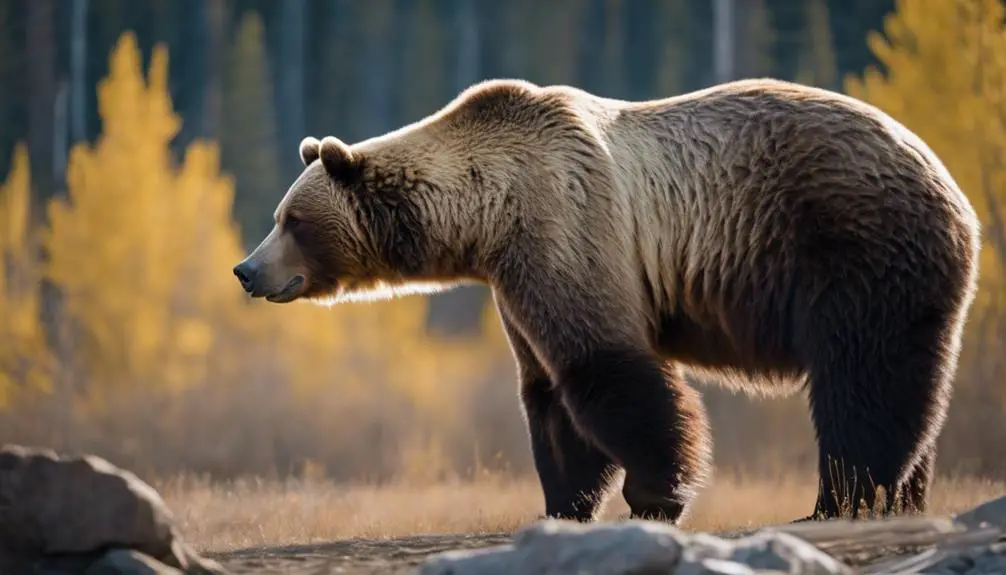
The size of a grizzly bear’s paw, measuring up to 8 inches in width, plays a vital role in their daily activities and survival in their natural habitat. Grizzly bear paws are equipped with five toes and curved, non-retractable claws that aid in digging and catching prey. These powerful paws enable grizzly bears to dig dens, catch fish, and forage for food in various terrains. The paw pads of grizzly bears provide essential traction and insulation, especially in snow and rough terrain, allowing them to navigate challenging environments with ease.
When grizzly bears walk, their paw prints leave distinct marks due to their large size and visible claw imprints. The dimensions of a grizzly bear’s paw aren’t only impressive but also essential for their daily functions, showcasing the remarkable adaptation of these majestic animals to their surroundings.
Next, let’s explore the fascinating dimensions of a grizzly bear’s head.
Grizzly Bear Head Dimensions
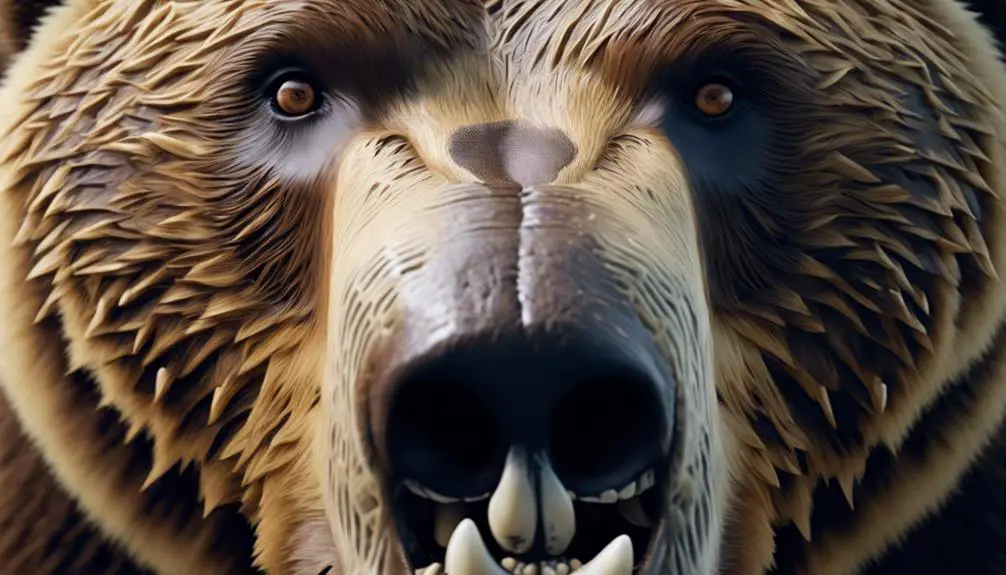
When considering grizzly bear head dimensions, it’s fascinating to note the average skull length and weight, which can vary between male and female bears.
The robustness of a grizzly bear skull, indicated by features like sagittal crests, speaks to the strength and muscle attachment capabilities of these formidable creatures.
Understanding the factors influencing skull size, such as age and nutrition, provides insight into the overall dimensions of a grizzly bear’s head.
Grizzly Bear Head Size
How significant is the head size of a grizzly bear in its hunting prowess and survival in the wild? The head plays a crucial role in a grizzly bear’s ability to detect and track prey. With an average head size ranging from 13 to 16 inches and skulls measuring up to 16-18 inches in length, these bears possess a broad-shaped head housing powerful jaws essential for hunting. Additionally, their well-developed cheek muscles aid in chewing various foods. Below is a table outlining the significant dimensions related to a grizzly bear’s head:
| Aspect | Measurement | Importance |
|---|---|---|
| Head Size | 13-16 inches | Detecting prey |
| Skull Length | Up to 16-18 inches | Hunting capabilities |
| Cheek Muscles | Well-developed | Chewing efficiency |
Grizzly Bear Skull Shape
Discussing the dimensions and shape of a grizzly bear’s skull offers valuable insights into its physical adaptations for hunting and survival in the wild.
The grizzly bear skull exhibits a distinct and robust structure, with a broader and more massive appearance compared to other bear species. One notable feature is the prominent sagittal crest, crucial for muscle attachment and enhancing the bear’s bite force.
Grizzly Bear Body Length
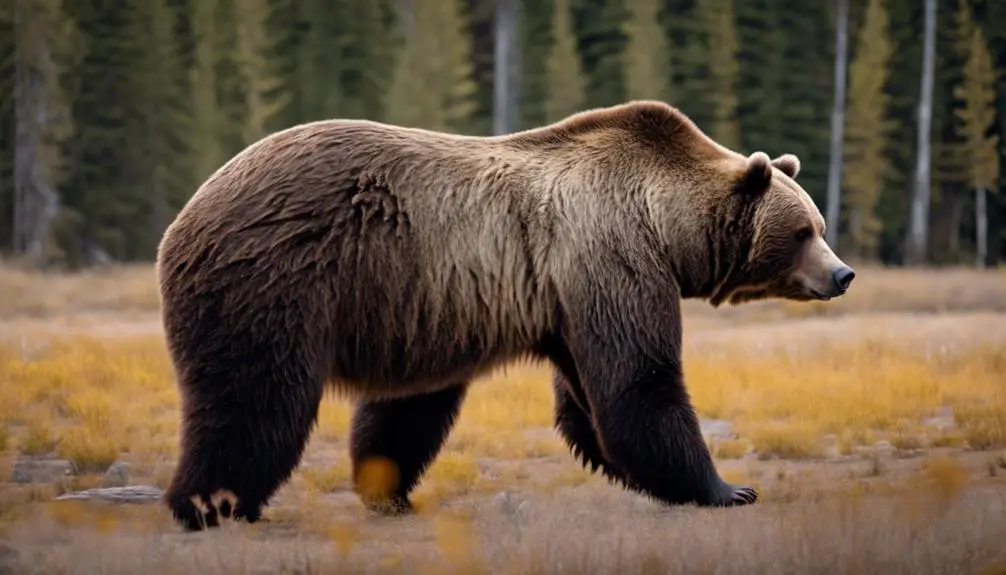
When comparing grizzly bear body length with humans, you’ll notice the significant size difference that can range from 56 to 88 inches.
Various factors, such as age, sex, and subspecies, influence the body length of grizzly bears. Understanding these factors is crucial in comprehending the vast range of sizes these magnificent creatures can reach.
Size Comparison With Humans
Grizzly bears boast a body length that ranges from 56 to 88 inches, equaling approximately 4.7 to 7.3 feet, showcasing their impressive size compared to humans. When standing on their hind legs, these bears can reach a height of 8 to 9 feet, towering over most individuals. Their body length significantly surpasses that of an average human, underlining their formidable size. To visualize this stark contrast, consider the following comparison table:
| Grizzly Bears | Humans |
|---|---|
| 56-88 inches | 5-6 feet |
Grizzly bears’ body length is a key factor contributing to their mass and strength, establishing them as one of the largest terrestrial mammals.
Factors Influencing Body Length
Factors influencing the body length of grizzly bears encompass genetics, age, nutrition, and overall health, pivotal in determining their size and physical prowess in the wild.
Male grizzly bears tend to have larger body lengths than females due to sexual dimorphism.
Environmental conditions and food resources play a significant role in determining the body length variation within grizzly bear populations.
Older grizzly bears may exhibit longer body lengths as they continue to grow over time.
The body length of a grizzly bear serves as a crucial indicator of its overall size and physical stature in the wild.
Understanding these factors provides insight into the intricacies of grizzly bear biology and the dynamics that shape their physical characteristics.
Grizzly Bear Shoulder Width
Typically, grizzly bears boast shoulder widths ranging from 36 to 46 inches, a key indicator of their size and strength. Male grizzly bears can have shoulder widths that reach up to 46 inches, showcasing their powerful build and imposing presence. In contrast, female grizzly bears generally exhibit shoulder widths between 30 to 38 inches, slightly smaller than their male counterparts but still impressive in stature.
The shoulder width of grizzly bears is a crucial measurement that contributes significantly to their overall size and strength. This attribute isn’t only essential for supporting their massive bodies but also plays a vital role in their physical capabilities, such as hunting and dominance within their habitats. When observing a grizzly bear, its broad shoulder width is often one of the first striking features that highlight the animal’s formidable nature.
Therefore, the shoulder width serves as a fundamental aspect of the grizzly bear’s stature, emphasizing their robust and commanding presence in the wild.
Grizzly Bear Leg Length
Grizzly bears’ leg length plays a significant role in their agility and speed.
Their slightly longer hind legs provide the power needed for quick movements in various terrains.
The adaptations in leg length allow them to swiftly navigate their environment, aiding in both hunting and evading threats.
Leg Length Variations
Grizzly bear leg lengths significantly impact their physical capabilities and performance in various environments. The variations in leg length among grizzly bears are closely tied to their body size, weight, locomotion, and agility. In their natural habitat, these variations play a vital role in how effectively they navigate their surroundings. Below is a table highlighting the importance of leg length in grizzly bears:
| Factors | Impact |
|---|---|
| Body Size | Proportional to leg length |
| Weight | Influences the strength and endurance |
| Locomotion | Longer legs aid in running speeds |
| Agility | Shorter legs provide better agility |
| Variations | Age, sex, and habitat influence leg length |
Impact on Movement
With their relatively short legs compared to body size, grizzly bears demonstrate remarkable agility and balance in their movements. The shorter legs give these bears a lower center of gravity, enhancing their stability while traversing various terrains in their environment.
Despite their compact leg length, grizzly bears can reach speeds of up to 56 km per hour, showcasing their impressive speed when needed. Their leg length is perfectly adapted for efficient movement, allowing them to navigate diverse environments ranging from dense forests to open grasslands with ease.
This unique adaptation not only aids in their survival but also enables them to thrive in different habitats by efficiently moving through their surroundings.
Adaptations for Environment
Navigating diverse terrains with ease, the grizzly bear’s compact leg length serves as a crucial adaptation for efficiently moving through its environment. The grizzly bear’s short legs provide stability and power, allowing it to dig and hunt effectively. Additionally, these shorter legs contribute to the bear’s balance and agility, essential for navigating rugged landscapes and catching prey. Despite their diminutive leg length, grizzly bears can sprint at speeds up to 30 miles per hour for short distances, showcasing their strength and agility. Their leg length is perfectly adapted to support their massive body size, enabling them to stand on their hind legs for improved visibility and to intimidate potential threats.
| Adaptation | Description | Importance |
|---|---|---|
| Short legs | Aid in stability and power | Digging and hunting |
| Balance | Maintain agility | Navigating terrain |
| Body size | Support massive weight | Standing upright |
Grizzly Bear Tail Length
Balancing and communicating, the grizzly bear’s tail ranges from 2 to 4 inches, relatively short compared to its body size. This short appendage plays a crucial role in maintaining balance and signaling intentions among grizzly bears. While not a primary tool for survival or locomotion, the tail is covered in fur, blending with the bear’s overall appearance.
The grizzly bear’s tail serves as a subtle yet effective means of communication within the species. Through slight movements and positioning of their tails, these bears can convey moods, intentions, and social cues to other bears in their vicinity. Despite its short length, the tail is an essential part of the grizzly bear’s body, aiding in various social interactions and behaviors.
Although not as prominent as other features, the grizzly bear’s tail remains an integral component of its anatomy, showcasing the intricate ways in which animals adapt for survival and social cohesion.
Grizzly Bear Ear Size
Measuring up to 7 inches in length, the ears of a grizzly bear play a crucial role in enhancing their sense of hearing for survival and communication purposes. These large ears aid grizzly bears in detecting sounds from long distances, improving their overall awareness in the wild. By having such sizable ears, grizzly bears can effectively detect predators or prey in their surroundings, contributing to their survival.
Additionally, the ear size of a grizzly bear is essential for communication, as it enables them to pick up vocalizations from other bears. This ability to perceive and interpret sounds is vital for social interactions and maintaining connections within the bear community.
Grizzly Bear Claw Length
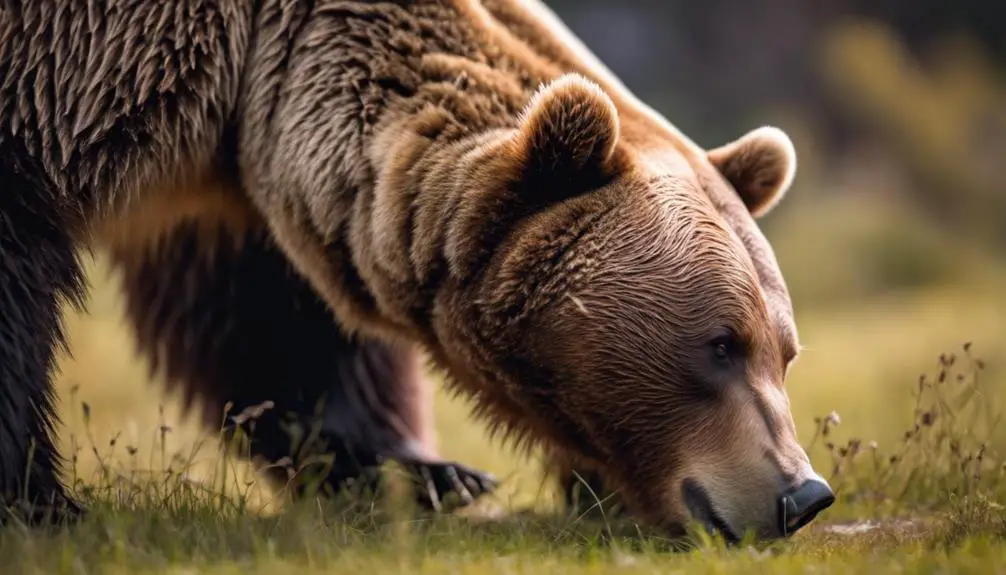
With their formidable claws ranging from 2 to 4 inches in length, grizzly bears possess essential tools for digging, catching prey, and survival in the wild.
The grizzly bear claws, known for their sharpness and strength, are crucial for various activities. These retractable claws help the bears in grasping and tearing food, as well as digging for roots and creating dens.
The curved shape of the claws allows for efficient catching of prey and tearing through tough hides. Grizzly bear claws aren’t only powerful but also versatile, enabling them to navigate through different terrains with ease.
The length of the claws can vary depending on factors like age, sex, and individual characteristics, with larger and older bears typically having longer claws. Overall, these strong and sharp claws are indispensable tools that aid grizzly bears in their daily activities and overall survival in the wild.
Grizzly Bear Teeth Dimensions
Grizzly bear teeth, comprising 42 teeth of various types, play a vital role in their survival and dietary needs in the wild. These teeth include sharp incisors for cutting, long canines measuring 2-4 inches in length for catching and holding prey, premolars for tearing food, and flat molars for grinding plant matter and tough foods.
The dimensions of grizzly bear teeth vary based on their omnivorous diet, allowing them to consume both meat and vegetation efficiently. The powerful canines are essential for hunting and defense, while the molars are crucial for processing a wide range of foods. Healthy teeth are indispensable for grizzly bears to thrive in their natural habitat, enabling them to obtain the necessary nutrients for their well-being.
The unique dimensions and arrangement of their teeth are perfectly suited to support the grizzly bear’s diverse diet and way of life in the wild.
Grizzly Bear Overall Body Dimensions
The size of a male grizzly bear can range from 36 to 46 inches in shoulder height, while females typically measure between 30 to 38 inches. Male grizzlies can weigh between 400 to 800 pounds, with females ranging from 300 to 400 pounds. Their body length spans from 56 to 88 inches, and they stand at a height of 8 to 9 feet.
In captivity, these majestic creatures can live up to 45 years, whereas in the wild, their lifespan averages between 20 to 25 years. These body dimensions play a crucial role in the overall appearance and physical capabilities of grizzly bears, allowing them to thrive in their natural habitats. Understanding these measurements provides insight into the impressive stature and strength of these animals, both in captivity and the wild.
Frequently Asked Questions
How Big Is a Full Grown Grizzly Bear?
A full-grown grizzly bear is massive, standing at 8-9 feet tall and weighing between 400-800 lbs for males and 300-400 lbs for females. Their sheer size and strength make them one of the largest land mammals.
How Big Is a Grizzly Bear Standing Up?
When a grizzly bear stands up, it can reach an impressive height of 8 to 9 feet, showcasing its size and strength. Females measure 30-38 inches at the shoulders, while males may be 36-46 inches tall.
What Is Bigger Polar Bear or Grizzly?
When comparing polar bears and grizzly bears, the former generally outweighs and stands taller than the latter due to their distinct habitats and physical adaptations. Polar bears’ larger size and stature are evident in various aspects.
How Big Is a Grizzly Bear at the Shoulder?
When standing on their hind legs, a grizzly bear can reach a shoulder height of 36-46 inches for males and 30-38 inches for females, showcasing their impressive stature and strength in the wild.

Erzsebet Frey (Eli Frey) is an ecologist and online entrepreneur with a Master of Science in Ecology from the University of Belgrade. Originally from Serbia, she has lived in Sri Lanka since 2017. Eli has worked internationally in countries like Oman, Brazil, Germany, and Sri Lanka. In 2018, she expanded into SEO and blogging, completing courses from UC Davis and Edinburgh. Eli has founded multiple websites focused on biology, ecology, environmental science, sustainable and simple living, and outdoor activities. She enjoys creating nature and simple living videos on YouTube and participates in speleology, diving, and hiking.

